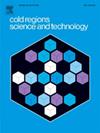Documenting, quantifying, and modeling a large glide avalanche in Glacier National Park, Montana, USA
IF 3.8
2区 工程技术
Q1 ENGINEERING, CIVIL
引用次数: 0
Abstract
Glide avalanches present a significant and repetitive challenge to many operational forecasting programs, and they are likely to become more frequent. While the spatial location of glide release areas is extremely consistent, the onset of glide avalanche release is notoriously difficult to forecast, and their destructive potential can be immense. Thus, the timing and dynamics of glide avalanches is an important area of study. To better understand these processes, and to improve assessments of risk to transportation corridors and infrastructure, event documentation is key. Here, we survey a large glide avalanche event along the Going-to-the-Sun Road in Glacier National Park, Montana, USA, during road opening operations in the spring of 2022. Using three sets of terrestrial lidar data (pre-event, post-event, and snow-off), we quantified key aspects of the avalanche and created powerful visualizations for analysis. Further, we evaluated meteorological data from automated weather stations between the onset of glide cracking and avalanche release. Last, we synthesized lidar data with a numerical dynamics model to replicate the event in a simulated environment. Using the tuned model, we determined the critical mean snow depth in the release area necessary for an avalanche to reach the road (4.2 m). Our method may be of particular use for glide avalanches, which tend to release in roughly the same place and time each year at a known interface. This could make the calculated critical depths more consistently reliable and preclude the need for additional tuning in dynamics models. As 1) lidar technology continues to improve and reduce in cost, 2) transportation corridors continue to extend into avalanche terrain, and 3) glide avalanches potentially become increasingly frequent, the synthesis outlined here provides a valuable tool for operational forecasters considering infrastructure threatened by glide events.
在美国蒙大拿州冰川国家公园记录、量化和模拟大型滑动雪崩
滑翔雪崩对许多业务预报程序来说是一个重大而重复的挑战,而且它们可能会变得越来越频繁。虽然滑翔释放区域的空间位置非常一致,但众所周知,滑翔雪崩释放的开始是难以预测的,而且它们的破坏性可能是巨大的。因此,滑翔雪崩的时机和动力学是一个重要的研究领域。为了更好地理解这些过程,并改进对运输走廊和基础设施的风险评估,事件记录是关键。在这里,我们调查了2022年春季道路开放期间,美国蒙大拿州冰川国家公园通往太阳路沿线的一次大型滑动雪崩事件。使用三组地面激光雷达数据(事件前、事件后和积雪),我们量化了雪崩的关键方面,并创建了强大的可视化分析。此外,我们评估了自动气象站在滑降开裂开始和雪崩释放之间的气象数据。最后,我们用数值动力学模型合成激光雷达数据,在模拟环境中复制该事件。使用调整后的模型,我们确定了雪崩到达道路所需的释放区域的临界平均雪深(4.2米)。我们的方法可能特别适用于滑动雪崩,这种雪崩倾向于在每年大致相同的地点和时间在已知的界面释放。这可以使计算出的临界深度更加一致可靠,并且避免了对动力学模型进行额外调整的需要。随着1)激光雷达技术的不断改进和成本的降低,2)交通走廊不断延伸到雪崩地形,3)滑翔雪崩可能变得越来越频繁,这里概述的综合为考虑到滑降事件威胁基础设施的业务预报员提供了一个有价值的工具。
本文章由计算机程序翻译,如有差异,请以英文原文为准。
求助全文
约1分钟内获得全文
求助全文
来源期刊

Cold Regions Science and Technology
工程技术-地球科学综合
CiteScore
7.40
自引率
12.20%
发文量
209
审稿时长
4.9 months
期刊介绍:
Cold Regions Science and Technology is an international journal dealing with the science and technical problems of cold environments in both the polar regions and more temperate locations. It includes fundamental aspects of cryospheric sciences which have applications for cold regions problems as well as engineering topics which relate to the cryosphere.
Emphasis is given to applied science with broad coverage of the physical and mechanical aspects of ice (including glaciers and sea ice), snow and snow avalanches, ice-water systems, ice-bonded soils and permafrost.
Relevant aspects of Earth science, materials science, offshore and river ice engineering are also of primary interest. These include icing of ships and structures as well as trafficability in cold environments. Technological advances for cold regions in research, development, and engineering practice are relevant to the journal. Theoretical papers must include a detailed discussion of the potential application of the theory to address cold regions problems. The journal serves a wide range of specialists, providing a medium for interdisciplinary communication and a convenient source of reference.
 求助内容:
求助内容: 应助结果提醒方式:
应助结果提醒方式:


